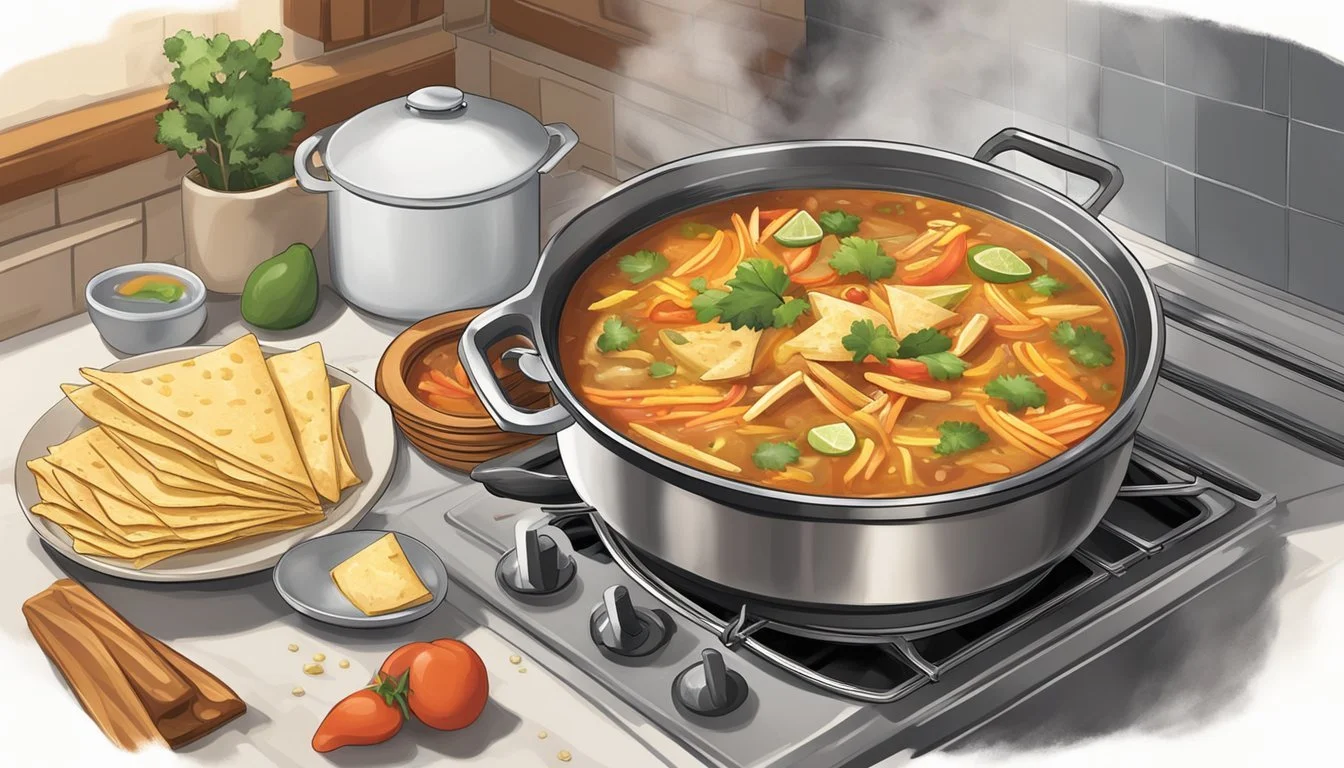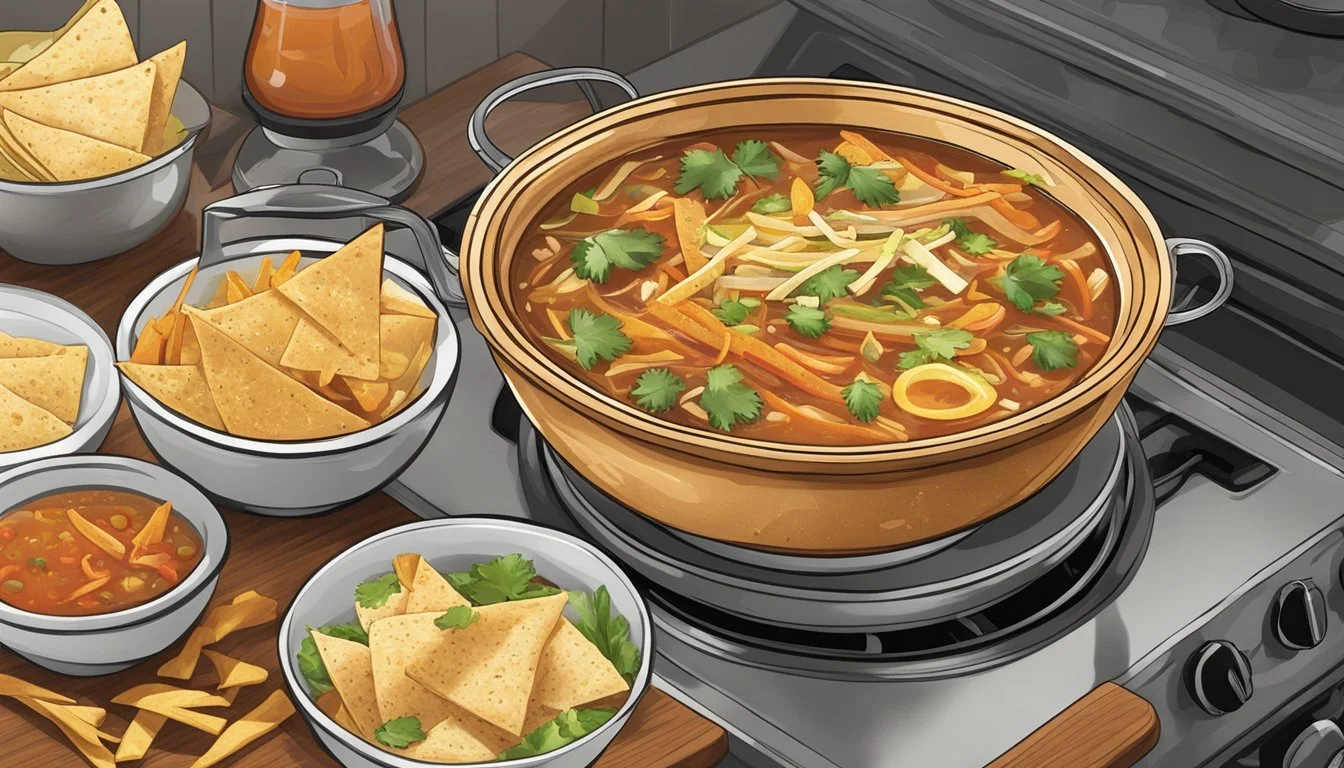Best Way to Reheat Tortilla Soup
Ensuring Hot Broth and Crispy Toppings
Tortilla soup, with its rich broth and an array of toppings, is a classic comfort dish. Achieving the perfect balance of temperature and texture is crucial when reheating chicken tortilla soup. The goal is to ensure that the broth is hot enough to be satisfying and safe to eat while keeping the toppings such as tortilla strips, cheese, and fresh herbs delightfully crispy and fresh.
The best method to reheat chicken tortilla soup involves a careful approach to both the broth and the toppings. For the broth, gentle heating on the stove allows for control and even distribution of heat, which is key to maintaining the soup’s flavor and preventing it from becoming overcooked. It's important to constantly stir the soup while reheating to help distribute the heat evenly.
As for the toppings, they require a different strategy. Crispy tortilla strips, for instance, should be reheated in an oven to preserve their desirable crunch. Adding them to the soup just before serving ensures they retain their texture. Other toppings, like shredded cheese, diced avocado, and fresh cilantro, are best added after the soup is reheated, thus keeping their distinct textures and flavors intact.
Understanding Tortilla Soup Components
Tortilla soup is a harmonious blend of ingredients that create a vibrant balance of flavors and textures. A traditional serving consists of chicken as the core protein, simmered in a chicken broth base infused with tomatoes, onion, and garlic. Each element contributes to the rich foundation of the soup.
Black beans and corn are classic stir-ins that offer a satisfying heartiness and sweetness, respectively. These ingredients maintain their distinct textures even after being immersed in the broth, contributing to the overall mouthfeel of the soup.
Freshness is introduced with chopped cilantro, a herb that delivers a citrusy, peppery taste which complements the deeper flavors of the soup. Avocado slices serve as a creamy counterpoint to the other components, notable for their buttery texture and subtle nuttiness.
Cheese, such as shredded pepper jack or cheddar, adds a layer of richness and gooeyness when it melts into the hot soup. This dairy element should be added just before serving to avoid becoming overly stringy or dissolving entirely into the mixture.
Lastly, the tortilla strips offer a necessary crunch, a textural contrast to the liquid and softer ingredients. These strips are best added at the final moment to preserve their crispness, ensuring a delightful snap with each spoonful.
Ingredient Contribution to Soup Chicken Protein, richness Tomatoes Acidic brightness, color Chicken Broth Base liquid, flavor Black Beans Hearty texture, earthy flavor Corn Sweetness, texture Onion Aromatic sweetness Garlic Pungent, umami depth Cilantro Freshness, light spicy flavor Avocado Creaminess, subtle flavor Cheese Melted richness, creamy texture Tortilla Strips Crunchiness, contrast in texture
By understanding these individual components and how they contribute to the final dish, reheating tortilla soup can be optimized to maintain an ideal balance of hot broth and crisp toppings.
Pre-Reheating Preparation
When reheating tortilla soup, it's essential to first prepare the ingredients to ensure the broth heats evenly and the toppings remain crisp. Proper separation and preparation of components like chicken and crispy tortilla strips can make a significant difference in the quality of the reheated soup.
Separating Broth and Toppings
Before reheating the soup, one should ensure that the broth and toppings are stored separately in the refrigerator. The toppings, especially crispy tortilla strips, should be kept in an airtight container at room temperature if they will be consumed quickly, or refrigerated to maintain their texture for a longer time. This preserves their crispness and prevents them from becoming soggy when mixed with hot broth.
Ingredients:
Broth
Crispy tortilla strips
Additional soup toppings
Storage:
Broth: Pour into a sealable container and store in the refrigerator.
Toppings: Store crispy tortilla strips and other toppings in separate airtight containers.
Instructions for Shredding Chicken
In preparing chicken breast (What wine goes well with chicken breast?) for tortilla soup, shredding it properly while cold ensures even reheating and maintains its texture. After the chicken breast has been fully cooked and cooled in the refrigerator, one should take the following steps to shred it:
Remove the chicken breast from the refrigerator.
Use two forks or clean hands to pull the meat apart into thin shreds.
Place the shredded chicken in a separate container from the broth.
Shredded Chicken:
Use fully cooked, cooled chicken breast.
Shred with forks or fingers.
Store separately from the broth for reheating.
Reheating Techniques for Optimal Flavor and Texture
Proper reheating of tortilla soup ensures that the broth remains hot while the toppings retain their crispiness. Employing the right technique can make a substantial difference in both flavor and texture.
Stovetop Simmering
For a quick and effective method, one can reheat tortilla soup on the stovetop. Stovetop simmering allows for precise temperature control, which is critical for avoiding overcooking. One should use a dutch oven or a heavy-bottomed pot to evenly distribute heat. Pour the soup into the pot and heat it over a medium-low setting, stirring occasionally. Once the soup reaches a simmer, it should be heated through while ensuring the toppings don’t become soggy.
Slow Cooker Method
Utilizing a slow cooker is ideal for reheating tortilla soup gently, especially when one needs to maintain its temperature over an extended period. The slower approach helps in preserving the essence and aroma of the soup. Simply add the soup to the slow cooker, set it to low, and allow it to warm for an extended period. A drizzle of olive oil before serving can enhance the flavor and add a silky texture to the broth.
Oven Reheating Approach
An oven reheating approach is less common but useful when serving a large quantity. Preheat the oven to a low temperature, around 250-300°F. Transfer the soup to an oven-safe container, preferably a dutch oven, which retains heat well. Covering the soup with a lid or foil, place the dutch oven in the preheated oven. This method warms the soup evenly and maintains precise temperature control.
Keeping Toppings Crispy
When reheating tortilla soup, preserving the crispness of the toppings, especially homemade tortilla strips, is crucial. One must consider the method of preparation and the timing of adding these crispy elements to maintain their desired texture.
Baking Crispy Tortilla Strips
For homemade tortilla strips, the oven is the ideal method to achieve that perfect crunch. Preheat the oven to 350°F (175°C), and line a baking sheet with aluminum foil. Cut corn or flour tortillas into 1/2-inch wide strips and spread them in a single layer on the sheet. A light spray of cooking oil, preferably olive oil for its flavor and high smoke point, enhances crispiness. Bake for 12-14 minutes, watching closely to prevent burning, until they reach a golden brown hue.
Best Oils for Frying
When frying tortilla strips, the choice of oil is significant. Olive oil and avocado oil are preferred due to their high smoke points and the subtle flavors they impart. To fry, heat oil in a pan over medium-high heat, add tortilla strips in batches to avoid crowding, and cook until they are golden and crisp. Drain them on a paper towel to remove excess oil.
Adding Toppings After Reheating
To prevent sogginess, add crispy elements such as tortilla strips or tortilla chips to the soup after reheating. One should serve toppings like these on the side, allowing diners to sprinkle them on top of their hot soup right before eating to ensure they retain their crunch.
Healthy and Nutritious Additions
When reheating tortilla soup, integrating nutritious ingredients can enhance both its flavor and health benefits. Maintaining the integrity of these additions during reheating ensures a delicious and wholesome experience.
Incorporating Vegetables
Adding a variety of vegetables not only contributes vital nutrients but also introduces an array of textures and flavors. Options include:
Tomatoes: Rich in antioxidants and vitamin C.
Onions: Offer a sweet and savory depth.
Corn: Adds natural sweetness and fiber.
Jalapeño: Provides vitamin C and a spicy kick.
Chilies: An additional source of capsaicin, which has metabolism-boosting properties.
When reheating, ensure that these vegetables are added towards the end of the warming process to maintain their crispness and nutritional value.
Choosing Low-Fat Proteins
Lean protein sustains energy levels and contributes to a feeling of fullness without added fats. Some healthy protein choices are:
Chicken Breast: Low in fat and high in protein.
Beans: A plant-based protein alternative that also offers fiber.
Proteins should be reheated to a safe internal temperature while avoiding overcooking, which can make them tough and less appealing.
Using Fresh Herbs
Herbs enhance the soup's flavor without the need for excess salt. They are best added fresh and just before serving:
Cilantro: Offers a fresh, citrusy flavor and is rich in antioxidants.
Parsley: Contains vitamins A and C and can brighten the soup's taste.
Garnishing with these herbs after reheating preserves their nutritional benefits and provides a vibrant contrast to the warmth of the soup.
Preservation and Storage Tips
Proper preservation is crucial for maintaining the quality of tortilla soup when storing leftovers. Whether in the refrigerator for short-term or the freezer for long-term storage, certain techniques ensure the broth stays flavorful and the toppings crisp.
Storing Soup in the Refrigerator
One should transfer the soup into an airtight container before placing it in the refrigerator. This method is ideal for keeping tortilla soup for up to three to four days. The key is to cool the soup to room temperature quickly, possibly by using an ice bath, which helps reduce the risk of bacterial growth.
Cooling Down: Room temperature within two hours.
Storage Container: Airtight and shallow.
Refrigerator Temperature: Below 40°F (4°C).
Storage Duration: Up to 3-4 days.
Freezing for Long-Term Storage
For those wanting to keep tortilla soup beyond a few days, freezing is the optimal choice. Soup should be cooled and stored in a freezer-safe bag or container, leaving some space to account for expansion. It's advisable to store the broth and toppings separately to maintain their distinct textures.
Freezer-Safe Container: Leave space for expansion.
Separating Components: Broth and toppings stored independently.
Freezing Temperature: Set freezer at 0°F (-18°C) or below.
Using Portions: Freeze in individual servings for convenience.
Avoiding Freezer Burn
To prevent freezer burn, one must ensure there is minimal air in the storage bags or containers. Freezer burn results from air reaching the food's surface, leading to dehydration and oxidation. Wrapping items tightly with freezer wrap or using heavy-duty freezer bags are excellent ways to protect them.
Air Removal: Expel as much air as possible from freezer bags.
Proper Sealing: Use heavy-duty freezer bags or tightly wrap with freezer wrap.
Labeling: Include the date on the label for proper rotation and usage.
Serving Suggestions
When serving tortilla soup, one should aim to enhance the dish with complementary garnishes, select pairings that align with the flavors, and create a full meal experience that delights the senses.
Garnishes That Enhance Flavor
Garnishes are essential for adding texture and boosting flavor. For tortilla soup, one should consider:
Citrus: A squeeze of fresh lime juice or lime wedges can brighten up the soup.
Herbs: Fresh cilantro leaves are a classic choice for infusing a fresh, herby note.
Creaminess: A dollop of sour cream adds a rich, cooling contrast to the heat of the soup.
Cheese: Shredded cheese, such as a Mexican blend or cheddar, melts into the hot broth providing a gooey texture.
Crunch: Crispy tortilla strips or chips deliver the necessary crunch that defines the dish.
Pairings with Tortilla Soup
While tortilla soup can stand on its own, certain side dishes can turn it into a more satisfying meal:
Crispy quesadillas or warm, soft tortillas for additional dipping.
A simple green salad dressed with a citrusy vinaigrette to complement the soup’s flavors.
Creating a Full Meal Experience
To convert a bowl of soup into a full meal, consider the following:
Starters: Begin with a light appetizer, like guacamole and chips.
Soup Toppings: Offer a variety of toppings so guests can customize their bowl:
Diced avocado adds creaminess.
Additional tortilla strips for those who prefer extra crunch.
Additional lime wedges and cilantro for an extra hit of freshness.
Incorporating these serving suggestions into the tortilla soup experience ensures each bowl is not just filling but also a harmonious balance of flavors, textures, and temperatures.
Conclusion
Reheating tortilla soup can be simple and effective when following the right methods. To maintain the flavor and texture of a classic chicken tortilla soup, careful reheating of the broth is essential. Whether using a microwave, stove top, or oven, it's important to heat the soup gradually and stir it occasionally to keep the broth hot and evenly warmed.
For the best experience, toppings should be stored separately and added after the broth is reheated. Crispy tortilla strips, fresh avocado, cheese, or sour cream provide the perfect contrast in textures. By keeping these components separate until serving, one ensures the integrity of the dish. The final result is a hot, savory broth with just the right amount of bite and zest from the toppings, reminiscent of the original dish.
Here are some final tips for reheating:
Microwave: Use a microwave-safe bowl. Heat in short intervals, stirring in between.
Stove top: Reheat in a pot over medium heat, stirring frequently.
Oven: Suitable for large quantities, covered, at a moderate temperature.
For those exploring soup recipes, particularly those contained within this comprehensive guide, remember that each step, from preparation to reheating, impacts quality. Easy chicken tortilla soup and similar one-pot wonders stand as testament to the art of simple, wholesome cooking, where flavors deepen over time. With the correct approach, the reheated soup can rival the fresh one in both taste and comfort.







